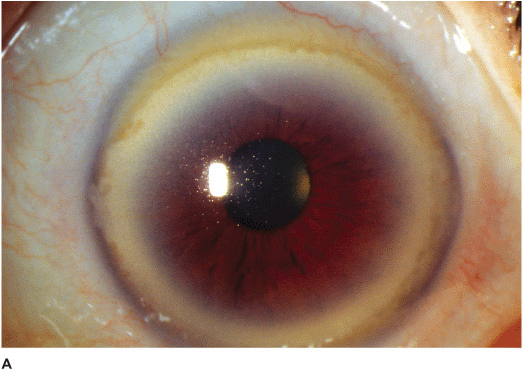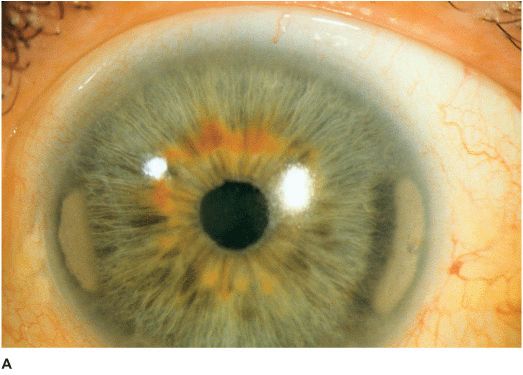CORNEAL DEGENERATIONS AND DEPOSITS
INVOLUTIONAL CHANGES
CORNEAL ARCUS
• Corneal arcus is a very common, bilateral condition that may be either age-related (arcus senilis) or associated with hyperlipidemia in younger individuals (arcus lipoides).
• Lipid deposits begin inferiorly, then superiorly, and later extend circumferentially to form a white perilimbal band about 1 mm in diameter with a sharp outline peripherally and a more diffuse boundary centrally. A clear zone of cornea separates it from the limbus (Figure 6-1A).
• May be accompanied by mild, nonprogressive thinning of the clear zone of cornea (furrow degeneration).
• Check for hyperlipidemia in patients under age 40 years. If unilateral, check for carotid disease on the uninvolved side.
• Patients are asymptomatic and ocular treatment is not necessary.
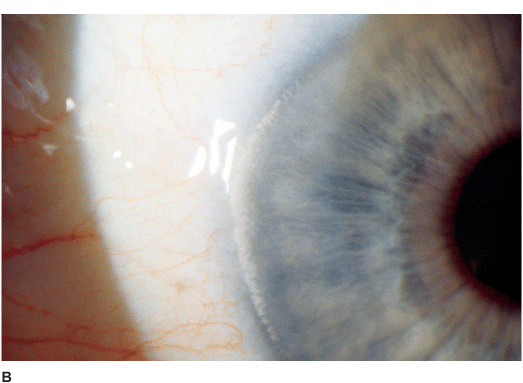
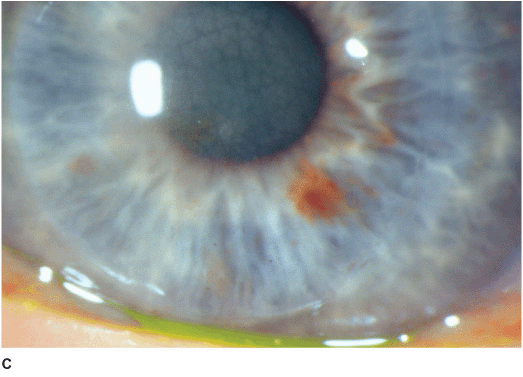

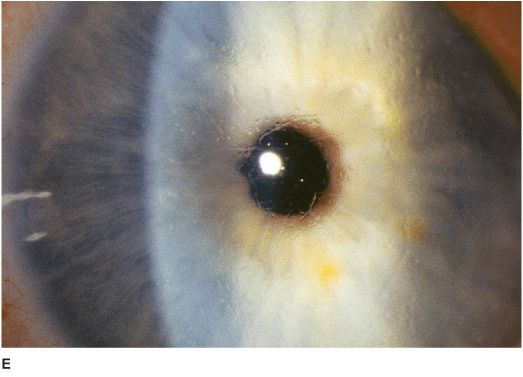
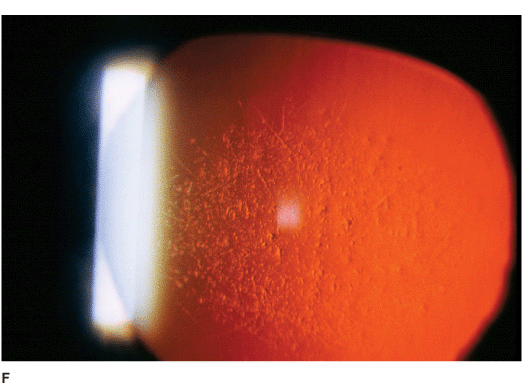
Figure 6-1 Corneal arcus A. A circular yellow-white lipid deposition is present adjacent to the limbus for 360 degrees. Note the clear zone between the arcus and the limbus. Limbal girdle of Vogt B. A crescentic, relatively dense white opacity is seen at the limbus at the 9 o’clock position. There is a small clear zone between the limbal girdle and the limbus. Crocodile shagreen C. Gray-white polygonal stromal opacities are evident in this corneal transplant. They may be located in the anterior or the posterior stroma. Cornea farinata D. Tiny, “flour-dust” deposits are seen at the pupillary margin. These pinpoint opacities are located in the deep stroma. They do not affect vision. Polymorphic amyloid degeneration E. Amyloid deposits in various shapes, including dots, commas, and lines, are seen in the corneal stroma. This condition is a degeneration, not a dystrophy. It is similar to lattice dystrophy in that they both involve amyloid deposition; however, lattice dystrophy is an inherited condition that is typically associated with recurrent erosions and decreased vision in young adulthood. F. This eye with polymorphic amyloid degeneration has dense central amyloid deposits readily seen in retroillumination off the retina.
WHITE LIMBAL GIRDLE OF VOGT
• White limbal girdle of Vogt is a very common, bilateral, innocuous, age-related condition characterized by chalky-white, crescentic deposits (elastotic degeneration) along the nasal and temporal perilimbal cornea. It may or may not be separated from the limbus by a clear zone (Figure 6-1B).
• Patients are asymptomatic and ocular treatment is not necessary.
CROCODILE SHAGREEN
• Crocodile shagreen is characterized by grayish-white, polygonal stromal opacities separated by relatively clear spaces. The lesions usually involve the anterior stroma (anterior crocodile shagreen), but they may also be found more posteriorly (posterior crocodile shagreen) (Figure 6-1C).
• Patients are asymptomatic and ocular treatment is not necessary.
CORNEA FARINATA
• Cornea farinata is a relatively common condition characterized by bilateral, innocuous, minute, “flour-dust” lipofuscinlike deposits in the deep stroma near Descemet’s membrane. It is most prominent centrally.
• These opacities are best seen with retroillumination off the iris (Figure 6-1D).
• Patients are asymptomatic and ocular treatment is not necessary.
POLYMORPHIC AMYLOID DEGENERATION
• Polymorphic amyloid degeneration is a fairly common, bilateral, innocuous, degenerative condition usually seen after the age of 50 years.
• It is characterized by polymorphic, refractile, punctate, comma-shaped and filamentous amyloid deposits throughout the stroma, but are generally most prominent centrally and posteriorly. These deposits are best seen with retroillumination off the retina (Figures 6-1E,F).
• It is not associated with any systemic disorder.
• Differential diagnosis: cornea farinata and lattice dystrophy.
• Patients are asymptomatic and ocular treatment is not necessary.
CORNEAL DEPOSITS—NONPIGMENTED
BAND KERATOPATHY
Band keratopathy is a common condition characterized by calcium deposits in the subepithelial space, Bowman’s layer, and anterior stroma.
Etiology
Ocular
• Chronic ocular inflammation (e.g., iridocyclitis, juvenile rheumatoid arthritis, corneal edema, interstitial keratitis, phthisis bulbi)
• Silicone oil in the anterior chamber
Metabolic
• Hypercalcemia or hyperphosphatemia
• Gout
• Chronic renal failure
Hereditary Familial
Other
• Chronic exposure to toxic vapors (e.g., mercury)
• Idiopathic (age-related)
Symptoms
• Often asymptomatic. If central, vision may be affected. Ocular irritation can develop if thick calcium plaques flake off and cause an epithelial defect.
Signs
• Peripheral, interpalpebral plaque of calcium deposit separated from the limbus by a thin line of clear cornea (Figures 6-2A,B,C).
• The plaque typically begins at the nasal and temporal cornea and extends centrally.
• It often contains small holes and clefts giving it a swiss-cheese appearance.
• Advanced lesions may become plaquelike, nodular, and elevated.
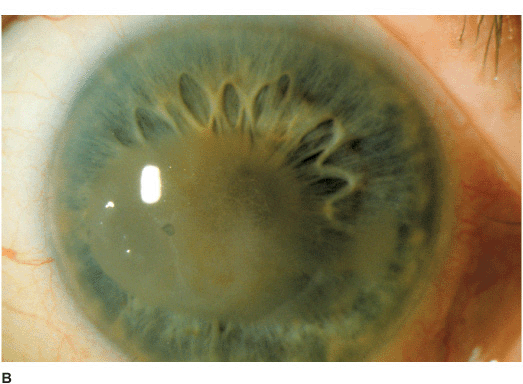
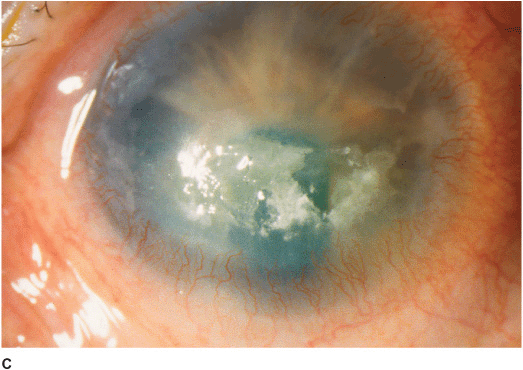
Figure 6-2 Band keratopathy A. A thin layer of calcium deposition can be seen adjacent to the limbus nasally and temporally. Note the thin line of clear cornea between the band keratopathy and the limbus. B. This eye had central calcium deposition obscuring the view of the iris and pupil. C. This eye with chronic corneal edema has a dense central plaque of calcium deposition. Some of the plaque spontaneously flaked off centrally.
Treatment
• Mild cases may be observed or treated with lubricants (e.g., artificial tear drops or ointments).
• Severe cases (with visual, painful, or cosmetic indications) can be treated with chelation using disodium ethylenediamine tetraacetic acid 3% or superficial keratectomy.
Prognosis
Excellent for the ocular calcium deposits. The band keratopathy can recur, especially if the underlying condition persists. Calcium chelation can be repeated if necessary. Epithelial healing problems may occur. Vision is often limited from other ocular pathology.
SALZMANN’S NODULAR DEGENERATION
Salzmann’s nodular degeneration is an uncommon, usually unilateral condition characterized by smooth gray-white elevated lesions of the cornea.
Etiology
• It is typically found in eyes with a history of chronic keratopathy, such as interstitial keratitis, vernal keratoconjunctivitis, keratoconjunctivitis sicca, phlyctenulosis, and trachoma, but may appear in otherwise normal eyes.
Symptoms
• Often asymptomatic. May affect vision if it becomes central; rarely causes a foreign body sensation if it becomes very elevated.
Signs
Stay updated, free articles. Join our Telegram channel

Full access? Get Clinical Tree


